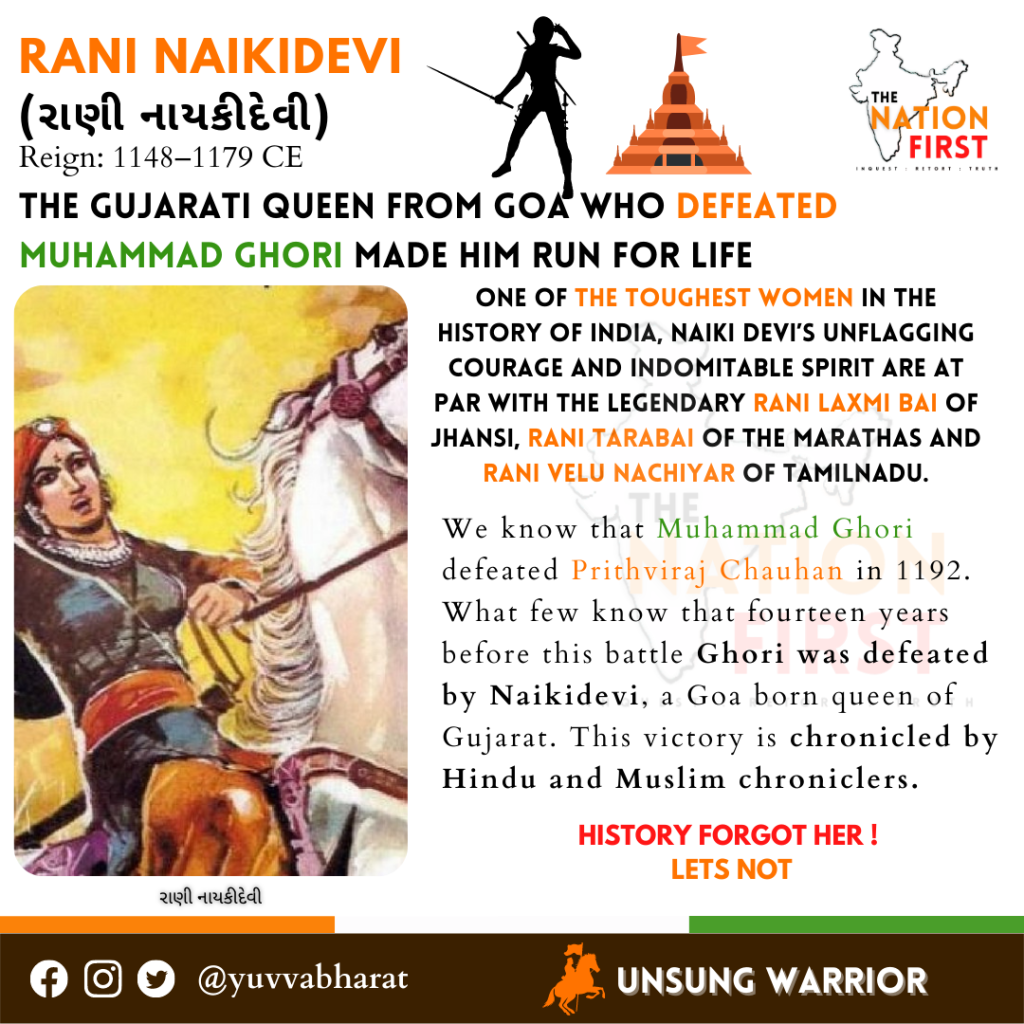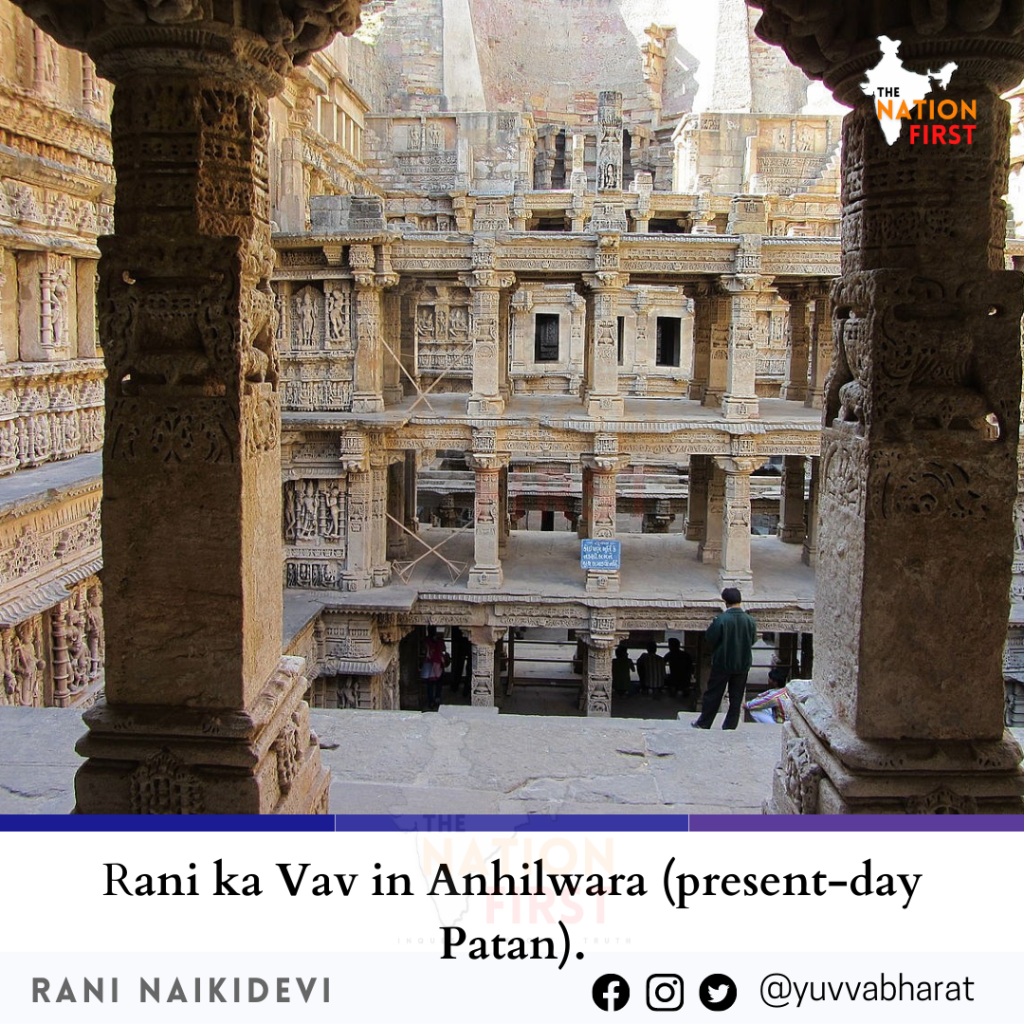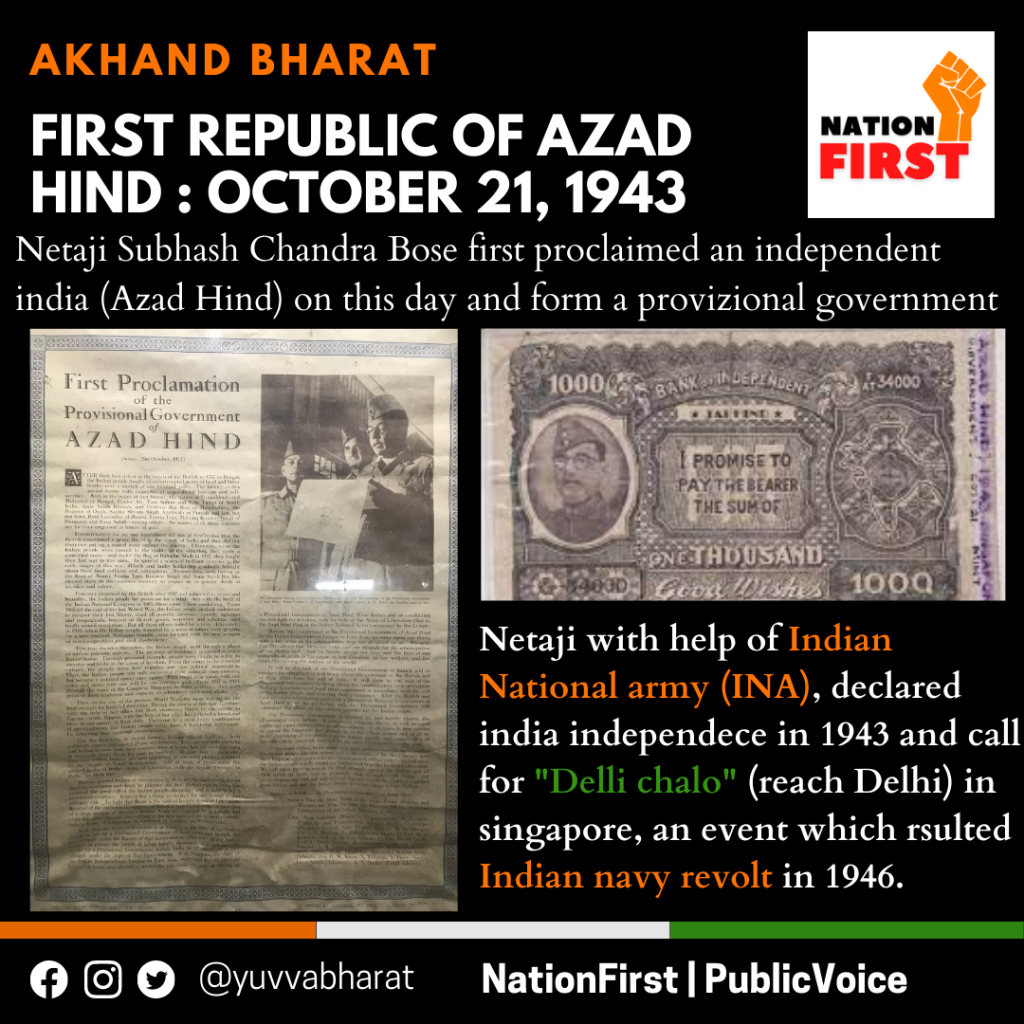We know that Muhammad Ghori defeated Prithviraj Chauhan in 1192. What few know that fourteen years before this battle Ghori was defeated by Naikidevi, a Goa born queen of Gujarat. This victory is chronicled by Hindu and Muslim chroniclers.
Being the daughter of the Kadamba king of Goa, Naikidevi was well-trained in military strategy, war tactics, cavalry and others elements of statecraft.
According to volume 5 of The History and Culture of Indian People published by the Bhartiya Vidya Bhawan pg 78,
“After the death of Kumarapala in A.D. 1171-72 Ajayapala, nephew of Kumarapala became kind. Ajayapala lost his life in A.D. 1176 and was succeeded by his young son Mularaja II, whose mother queen Naikidevi, the daughter of the Kadamba Paramardin, the king of Goa acted as agent”.
Bhartiya Vidya Bhawan
In A.D 1178 Muhammad Ghuri (Ghori) attacked the kingdom of Gujarat. Naikidevi, taking her son in her lap, led the Chalukyan army against the Muslims and defeated them at Gadaraghatta near Mount Abu.”
From the works of Merutunga, a Jain scholar of the 14th century comes the most appropriate description of Naikidevi defeat of Muhammad Ghori. One of Merutunga’s chief work, Prabandha Chintamani, is where one can find details of how the queen fought the armies of Ghori at Kyara or Gadararaghatta near the foot of Mount Abu.
Hidden History of Queen Naikidevi
The history of the Chalukyas of Gujarat has never suffered from want of historians since Hemachandra wrote his Dvyāśrayakāvya. His lead in this field of literature was followed by many writers such as, Someśvara, Somaprabha, Chandraprabha or Prabhachandra, Balāchandra, Udayaprabha, Merutunga, Jayasimha Suri and others. Many of these authors really wrote the biography of Kumarapala or of Vastupala and Tejahpala, but even such biographies usually contained a canto, or, if the whole work consisted of a short prasasti, several verses, in praise of the Chalukya kings. The information thus left is, however, often of the greatest importance for reconstructing the history of the Chalukyas of Gujarat.
Far more remarkable than the heroic ‘Veergati’ of Lakshmibai, the Queen of Jhansi, was this dazzling victory in the annals of Bharat scored by a valiant woman against a treacherous, ruthless, and barbaric invader compared to whom the British foe would look like a fine flower of civilization. Yet somehow the history of Naikidevi is little known to the people of Bharat.
Mularaja-II, or Bala Mularaja as he is affectionately called by the Chroniclers, ascended the throne of his father Ajayapala in 1175 CE, while still a boy. His mother was Naikidevi, the daughter of one Paramardin, who has been identified with the Goa Kadamba Mahamandalesvara Permadi or Sivachitta (circa 1147-1188 CE). The earliest known inscription of Mularaja’s brother and successor Bhima-II, is dated 1179 CE. Hence the reign of Mularaja-II lasted for not more than three years.

The most important event in the short reign of this boy king was the sanguinary defeat he inflicted on a Muslim army. The inscriptions of his successors invariably describe him as: prabhuta-durjaya-Garjanak-adhiraja, or Mlechchha-tamo-mchaya-chchhanna-mahi-valaya-pradyotana-valarka.
The Chroniclers rightly single out the defeat of the Muslims as the only incident worthy of being remembered about Mularaja. Somesvara states that Mularaja defeated the lord of the Turushkas, and vanquished the Mlechchha army. Balachandra states that King Mularaja, though an infant, defeated the Mlechchha king. Arisimha also refers to Mularaja’s victory over the Muslims, and an inscription of Bhima’s reign states that during the reign of Mularaja a woman had defeated Hammira (Amir).
A more detailed description of the battle is given by Merutuñga who states that Mularaja’s mother Queen Naikidevi, the daughter of Paramadin, taking her son in her lap, fought at a ghat called Gadararaghatta (near the foot of Mount Abu) and conquered the king of the Mlechchhas by the aid of a mass of rain clouds that came out of season attracted by her virtue. Apparently, Merutuñga could not check the temptation of improving his narration by introducing supernatural elements in aid of human valour in order to impress his readers.
However, it is evident that Naikidevi defeated a Muslim army; but, as none of the Chroniclers name the invader, there is some difficulty in identifying him. Forbes, Buhler, Jackson, Hodivala, and Habibullah are of the opinion that the defeated Muslim army was led by Mu’izz ud-din Muhammad bin Sam, better known as Muhammad Ghori. But the Muslim historians are unanimous in stating that the victor of Mu’izz ud-Din was Bhim Dev, king of Nahrwala, i.e. Bhima-II, the brother and successor of Mularaja-II. An inscription at Kiradu which mentions Bhima as the reigning monarch and records the repairs to a temple broken by the Turushkas is dated 1178 CE. As the invasion of Mu’izz ud-Din also took place in the same year (1178 CE), some scholars have assumed, on the authority of the Muslim sources alone, that Bhima defeated the Muslim army of Mu’izz ud-Din. But, if this assumption is accepted the difficulty would be to identify the Muslim army which was defeated by Mularaja, as between 1175-1178 CE the only recorded Muslim invasion was the one led by Mu’izz ud-Din, in 1178 CE.
It is important to emphasize here that the inscriptions of Bhima invariably give Mularaja the epithet of conqueror of Garjanakas (dwellers of Ghazni) etc., while never mentioning that Bhima ever defeated a Muslim army. It is more probable that Muslim historians would be wrong about the name of the Hindu monarch who must have died shortly after the battle was fought, than that all the chronicles written during the reign of Bhima should overlook his splendid military achievement, just as his inscription writers had done; such a conspiracy of silence is not probable. We must therefore conclude that Queen Naikidevi,acting as regent of Mularaja, defeated the army of Mu’izz ud-Din when he attacked Gujarat in 1178 CE.
Continue reading here : Invasion of Gujarat by Mu’izz ud-Din (Muhammad Ghori) and after math of war.
Invasion of Gujarat by Mu’izz ud-Din (Muhammad Ghori)



